Folklore and legends are the tapestry of human history, weaving together stories that transcend generations and cultures. These tales, rich with the imagination and wisdom of our ancestors, offer a glimpse into the values, fears, and aspirations of societies long past. From the clever tricks of Anansi the spider in West African lore to the haunting legends of ghostly samurais in Japan, folklore encapsulates the diverse ways humans have sought to explain the mysteries of the world.
In this article, we will explore ten fascinating folklore and legends from around the globe, each offering a unique window into the human experience and the cultural heritage of different civilizations. Prepare to journey through time and across continents as we delve into these captivating narratives that continue to enchant and educate us today.
1. The Legend of King Arthur (Britain)

(picryl.com)
The tale of King Arthur, one of the most enduring legends in Western culture, is a captivating blend of history, myth, and chivalry. According to folklore, Arthur was a British monarch who rose to prominence through the miraculous pulling of the sword Excalibur from a stone, an act that signified his rightful claim to the throne. The legend places him at the heart of a golden age of knighthood, where he founded the Round Table, a symbol of unity and equality among his knights. This table, which allowed knights to sit in equal status, embodies the ideals of camaraderie and shared purpose.
Arthur’s reign is marked by his quest for the Holy Grail, a sacred object that symbolizes divine grace and purity. This quest, alongside his knights’ adventures, illustrates themes of nobility, honor, and the pursuit of higher ideals. Central to the legend are characters such as Merlin, the wise and mysterious wizard who aids Arthur with his prophetic insights and magical abilities, and Guinevere, Arthur’s queen whose love for Sir Lancelot adds layers of complexity and tragedy to the narrative.
The legend of King Arthur not only reflects the ideals of chivalry and heroism but also serves as a mirror to medieval society’s values and aspirations. The stories of Arthur and his knights, with their battles against evil and quests for justice, resonate with themes of moral integrity and leadership. These tales have been immortalized in various forms of literature, from medieval romances to contemporary adaptations in film and television.
The influence of the Arthurian legend extends beyond its historical and literary significance. It has inspired countless adaptations and interpretations, blending history with myth and influencing the fantasy genre. The legend’s enduring appeal lies in its rich tapestry of magical elements, heroic deeds, and moral quests, making it a central piece of Western mythological tradition and a source of inspiration for generations.
2. The Tale of the Monkey King (China)

(goodfon.com)
The “Journey to the West” is one of China’s most cherished literary classics, featuring the Monkey King, Sun Wukong, as its central figure. This epic novel, attributed to the Ming Dynasty writer Wu Cheng’en, chronicles Sun Wukong’s transformation from a mischievous and rebellious monkey to a pivotal hero in a grand quest. Sun Wukong, endowed with remarkable strength, magical abilities, and a trickster’s wit, initially defies the heavens, leading to his confinement under a mountain by the Buddha. His tale begins with a desire for immortality and power, which is tempered by his eventual quest for enlightenment and redemption.
Sun Wukong’s journey is intricately tied to the pilgrimage of the monk Xuanzang, who is tasked with retrieving sacred Buddhist scriptures from India. Freed from his mountain prison on the condition that he assists Xuanzang, Sun Wukong becomes an indispensable protector and companion. His magical abilities, such as shapeshifting, flying, and wielding a size-altering staff, are crucial in overcoming the numerous challenges and supernatural adversaries they encounter. The dynamic between Sun Wukong’s brashness and Xuanzang’s unwavering devotion provides a rich narrative tension, highlighting themes of loyalty, discipline, and the quest for spiritual enlightenment.
Throughout their adventures, Sun Wukong evolves from a defiant trickster into a loyal and wise ally. His journey reflects a deeper spiritual quest, illustrating his growth and the internal struggle between his rebellious nature and his desire for redemption. This transformation is a central theme of the epic, symbolizing the triumph of virtue over vice and the pursuit of a higher moral purpose. The Monkey King’s character embodies both the complexity of human nature and the ideals of personal growth and enlightenment.
“Journey to the West” has profoundly influenced Chinese culture, inspiring numerous adaptations in literature, theatre, film, and television. Sun Wukong’s enduring popularity attests to his appeal as a symbol of courage, intelligence, and resilience. The epic’s rich tapestry of adventure and spirituality continues to captivate audiences, cementing its place as a cornerstone of Chinese cultural heritage and a universal tale of transformation and redemption.
3. The Myth of the Phoenix (Egypt)

(flickr.com)
In ancient Egyptian mythology, the Phoenix is a powerful symbol of renewal, immortality, and the cyclical nature of life. This mythical bird, renowned for its magnificent appearance and vibrant plumage, is believed to live for several centuries before meeting a dramatic end. As the Phoenix reaches the end of its life, it spontaneously bursts into flames, burning itself to ashes. However, this fiery demise is not the end but rather a prelude to rebirth. From the ashes of the old Phoenix, a new bird arises, signifying the endless cycle of life and death, and embodying the concept of regeneration.
The Phoenix’s role in Egyptian mythology is closely intertwined with the sun god Ra, who represents creation, renewal, and the eternal cycle of the sun. The bird’s cyclical rebirth mirrors the daily rising and setting of the sun, reinforcing the connection between divine energy and natural processes. This mythological bird thus becomes a potent symbol of the sun’s rejuvenating power, reflecting the ancient Egyptians’ beliefs about the continuity of life and the promise of eternal renewal.
The legend of the Phoenix extends beyond Egyptian culture, influencing various other traditions and mythologies. In Greek mythology, the Phoenix shares similar characteristics, symbolizing resurrection and eternal life. The bird’s ability to rise from its own ashes appears in Roman, Persian, and Chinese myths as well, each adapting the story to their own cultural contexts. This widespread presence underscores the Phoenix’s universal appeal as a symbol of hope, resilience, and the triumph over adversity.
Today, the myth of the Phoenix continues to inspire modern literature, art, and popular culture. Its powerful imagery of rebirth and transformation resonates with contemporary audiences, serving as a metaphor for overcoming challenges and emerging stronger from adversity. The Phoenix remains a compelling emblem of the human spirit’s capacity for renewal and perseverance, reflecting its enduring significance across cultures and time periods.
4. The Story of Anansi the Spider (West Africa)

(flickt.com)
Anansi, a central figure in West African folklore, particularly among the Akan people of Ghana, is celebrated as a trickster spider deity renowned for his extraordinary cleverness and cunning. His stories, rich in humor and wit, are deeply embedded in the cultural fabric of Ghanaian traditions. Anansi is often depicted as a small spider with the ability to outsmart gods, humans, and animals through his ingenious schemes. These tales not only entertain but also impart important moral lessons about the virtues of intelligence, resourcefulness, and the consequences of greed.
The origins of Anansi’s stories can be traced to the Akan people, where they serve as a medium for passing down cultural values and societal norms. In these tales, Anansi’s adventures frequently involve his attempts to solve problems or achieve goals through trickery and cunning rather than brute force. For example, he might deceive more powerful beings to obtain food or gain respect. His success despite his small size highlights the theme that intelligence and strategy can triumph over physical strength and power.
As the African diaspora spread across the Caribbean and the Americas, Anansi’s stories traveled with it, adapting to new cultural contexts while retaining their essential themes. In the Caribbean, Anansi became a symbol of resistance and resilience, embodying the struggles and ingenuity of enslaved Africans and their descendants. The tales were adapted to reflect local customs and experiences, making Anansi a figure of cultural pride and a vehicle for expressing social and political commentary.
In contemporary times, Anansi’s influence extends beyond traditional folklore into modern literature, art, and popular culture. His tales continue to be a source of inspiration, offering timeless lessons on the value of cleverness and adaptability. Anansi’s enduring appeal underscores the power of folklore to shape cultural identity and convey moral teachings, demonstrating the lasting impact of these stories across generations and cultures.
5. The Legend of the Chupacabra (Latin America)
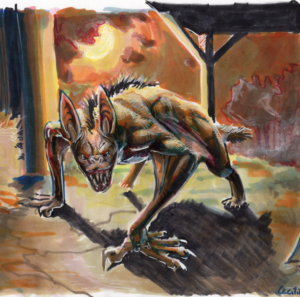
(deviantart.com)
The Chupacabra, whose name translates to “goat-sucker,” is a notorious figure in Latin American folklore, famed for its chilling reputation. Emerging in the mid-1990s, particularly in Puerto Rico, this legendary creature is said to drain the blood of livestock, especially goats. The creature’s alleged attacks leave behind eerily punctured carcasses, fueling widespread fear and fascination. Although the phenomenon initially appeared localized, reports and sightings of the Chupacabra have spread across Latin America, adapting and evolving with each telling.
Descriptions of the Chupacabra vary widely, reflecting the diverse nature of the legend. In many accounts, it is depicted as a reptilian creature with spiked or spiny dorsal ridges, sometimes described with features resembling those of a large, gaunt dog with a thin, emaciated body. Other portrayals suggest a more alien or humanoid appearance with glowing eyes and sharp claws. The inconsistencies in its descriptions contribute to its mystique and the continued debate over its true nature.
The Chupacabra legend taps into deeper anxieties about livestock management and environmental changes. In rural communities where livestock is a vital economic asset, unexplained and sudden deaths of animals can be devastating. The Chupacabra provides a fantastical explanation for these occurrences, often reflecting concerns about the impact of environmental shifts or disease. As such, the legend serves both as a way to explain mysterious animal deaths and as a cultural response to changing rural landscapes.
In modern times, the Chupacabra has transcended its folkloric origins to become a prominent figure in urban legends and cryptozoology. It features prominently in books, films, and television programs, embodying the human fascination with the unknown and the supernatural. The legend’s persistence highlights our ongoing intrigue with mythical creatures and the ways in which contemporary myths adapt to address modern fears and uncertainties.
6. The Myth of the Kappa (Japan)
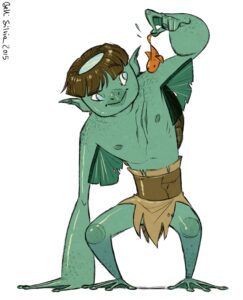
(deviantart.com)
In Japanese folklore, the Kappa is a striking water spirit known for its unique appearance and intriguing behaviors. Typically depicted as a green, amphibious creature with a humanoid form, the Kappa is most recognizable by the water-filled dish, or “sara,” atop its head. This dish is central to the Kappa’s strength; it is believed that as long as the dish remains filled with water, the Kappa retains its power and magical abilities. However, if the water spills, the Kappa loses its strength and becomes powerless, making the dish a vital aspect of its mythical existence.
The Kappa is renowned for its mischievous and sometimes dangerous behavior. It is known to engage in playful pranks and tricks, particularly targeting humans who venture too close to water bodies such as rivers, ponds, or lakes. These pranks can range from harmless practical jokes to more perilous acts, such as attempting to drag people into the water or challenge them to contests of strength. Despite the Kappa’s often troublesome nature, its stories serve as cautionary tales, warning people to exercise respect and caution around natural water sources.
Interestingly, the Kappa also embodies certain positive qualities. The creature is reputed to have knowledge of medicine and healing, and in some legends, it assists humans in agricultural tasks or offers remedies for ailments. To appease the Kappa, people often offer cucumbers, which are said to be its favorite food. These elements of the Kappa’s lore highlight its dual nature—both mischievous and beneficial, reflecting a nuanced view of this mythical entity.
The Kappa’s legacy extends into modern Japanese culture, where it appears in various forms of media such as anime, manga, and films. Its enduring presence underscores its significance as a cultural symbol, representing the interplay between nature, caution, and the mystical. The Kappa continues to captivate imaginations, offering timeless lessons through its mythical antics and interactions.
7. The Story of El Chupacabra (Chile and Argentina)
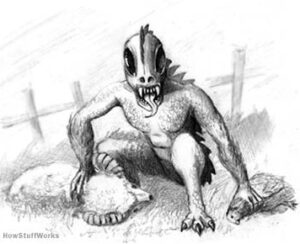
(commons.wikipedia)
In Chile and Argentina, the legend of El Chupacabra mirrors the broader Latin American myth of a creature that preys on livestock, but with distinct regional variations. Unlike the more reptilian or canine depictions found elsewhere, El Chupacabra in these countries is often described as having a more humanoid appearance. Witnesses report seeing a creature with a strange, almost human-like body, elongated limbs, and a menacing, skeletal face. This variation of the Chupacabra legend began gaining traction in the late 1990s, adding a unique twist to the wider mythos.
The appearance of El Chupacabra in Chile and Argentina is often linked to mysterious and unexplained animal deaths. Farmers and rural residents have reported finding their livestock dead with strange puncture wounds and seemingly drained of blood. These unsettling discoveries have fueled fears and speculation about the creature’s true nature. The Chupacabra’s elusive nature—often described as a shadowy, almost spectral being—adds to the sense of dread and uncertainty surrounding these incidents.
In these regions, the legend of El Chupacabra serves as a contemporary symbol of rural anxieties and the fear of the unknown. The distress caused by unexplained livestock deaths, combined with the enigmatic and disturbing characteristics attributed to El Chupacabra, reflects deeper concerns about environmental changes, disease, or even possible external threats. The myth provides a dramatic and sensational explanation for these occurrences, helping to make sense of the inexplicable and offering a scapegoat for otherwise troubling events.
The story of El Chupacabra has transcended its folkloric origins to become a prominent figure in popular culture and media. It appears in news reports, cryptozoology discussions, and various forms of entertainment, continuing to captivate the imagination of people both within and beyond Chile and Argentina. The enduring appeal of the Chupacabra underscores its role as a symbol of the supernatural and a reflection of modern fears, maintaining its place in the pantheon of mythical creatures.
8. The Legend of the Wendigo (North America)

(commons.wikipedia)
The Wendigo is a prominent figure in Algonquian folklore, originating from the cultural traditions of the First Nations people in the northern forests of North America. Described as a malevolent spirit or monstrous being, the Wendigo is often depicted with emaciated, skeletal features and an insatiable hunger for human flesh. This fearsome creature embodies extreme greed and gluttony, symbolizing the ultimate excess and moral decay. The Wendigo’s ghastly appearance and voracious appetite make it a powerful symbol of the dangers of unchecked desires.
Central to the Wendigo legend is its association with cannibalism, a taboo within Algonquian cultures. The myth suggests that a person who engages in cannibalism or becomes consumed by greed may transform into a Wendigo. This transformation reflects a deeper moral lesson about the consequences of extreme selfishness and ethical corruption. The Wendigo serves as a stark warning against succumbing to the darker impulses of human nature, emphasizing the importance of maintaining communal values and ethical behavior.
The Wendigo legend also captures the fears and challenges associated with survival in harsh, northern environments. The creature represents the terror of starvation and the psychological effects of extreme hunger. In times of scarcity, the myth reinforces the need for community support and cooperation. The Wendigo’s insatiable hunger symbolizes the destructive potential of individualism and the importance of communal harmony during difficult times.
In contemporary culture, the Wendigo has transcended its traditional folkloric origins to become a significant figure in horror fiction and popular media. Appearing in literature, films, and television, the Wendigo is often portrayed as a supernatural antagonist or a symbol of human depravity. Its enduring presence underscores its role as a potent symbol of greed and moral corruption, captivating audiences with its chilling and cautionary tales that continue to resonate in modern storytelling.
9. The Tale of the Thunderbird (Native American)
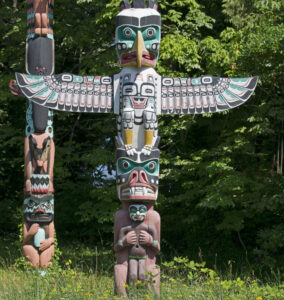
(commons.wikipedia)
The Thunderbird is a central figure in Native American mythology, particularly among the Indigenous peoples of the Pacific Northwest, including the Coast Salish, Haida, and Kwakwaka’wakw tribes. This mythical bird is renowned for its immense power and spiritual significance, often depicted as a colossal avian creature whose wings are said to generate thunder and lightning. The Thunderbird’s ability to command the elements reflects its status as a potent symbol of strength and natural force.
In the lore of these Native American cultures, the Thunderbird plays a vital role in creation myths and cultural stories. It is frequently described as a majestic bird with wings so powerful that their flapping creates thunder, while its eyes flash like lightning. The Thunderbird is not only a figure of awe but also a guardian and protector. It is believed to ward off evil spirits and safeguard the community, embodying both the might of nature and the spiritual protection afforded to the people.
The Thunderbird’s influence is evident in various forms of Native American art and cultural expression. Its image appears prominently on totem poles, carvings, and ceremonial artifacts, serving as a representation of the Thunderbird’s divine attributes and its role in spiritual practices. These artistic depictions highlight the Thunderbird’s importance as a symbol of power and protection, integrating its mythological presence into the daily and ceremonial life of Indigenous communities.
Today, the Thunderbird continues to be a powerful symbol in Native American culture and beyond. Its legacy endures in modern storytelling, art, and public consciousness, embodying the enduring respect for natural forces and spiritual guardianship. The Thunderbird remains a potent emblem of nature’s power and the spiritual connection between Indigenous peoples and the natural world, demonstrating its lasting impact on cultural identity and heritage.
10. The Legend of the Banshee (Ireland)
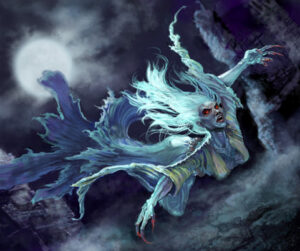
(commons.wikipedia)
In Irish folklore, the Banshee is a spectral figure who plays a unique and poignant role as a harbinger of death. Known for her mournful wails and shrieks, the Banshee is believed to foretell the death of a family member or clan member. Her cries are said to serve as a supernatural warning, signaling the impending loss and marking the approach of death. Traditionally, the Banshee is associated with specific families or clans, suggesting a deeply personal connection between the spirit and the fate of those she warns.
Depictions of the Banshee often portray her as a ghostly woman with an unsettling appearance. She is commonly described with long, flowing hair and a sorrowful or mournful expression. The intensity of her cries is said to be so profound that they evoke fear and sorrow among those who hear them. The Banshee’s role is not to cause death but to signify its imminent arrival, serving as a spectral messenger between the realms of the living and the dead. Her haunting presence underscores the personal and familial nature of her warnings.
The legend of the Banshee reflects deep themes of loss, mortality, and the afterlife. Her role in folklore emphasizes the intersection of the supernatural with personal fate, where her wailing represents a bridge between the living and the deceased. The Banshee’s appearance and cries are woven into the cultural fabric of Irish traditions surrounding death and mourning, highlighting the significance of ancestral connections and the rituals associated with passing.
In contemporary culture, the Banshee continues to captivate imaginations and appears in various forms of media, including literature, films, and television. Her enduring presence in popular culture underscores her role as a symbol of supernatural forewarning and the inevitability of death. The Banshee remains a powerful emblem of the connection between the human experience and the spiritual realm, reflecting her lasting impact on Irish myth and legend.
Conclusion,
As we conclude our journey through the mesmerizing world of folklore and legends, it’s evident that these stories are more than mere entertainment. They are cultural treasures, preserving the collective wisdom, values, and fears of civilizations from different corners of the globe. Each tale, whether it be the cunning exploits of Anansi the spider, the heroic deeds of mythical warriors, or the eerie accounts of ghostly apparitions, reflects the unique worldview and historical context of the people who told them.
These legends continue to captivate our imagination, offering timeless lessons and a deep sense of connection to our shared human heritage. By exploring these fascinating narratives, we not only honor the rich tapestry of global folklore but also enrich our understanding of the diverse ways humanity has sought to make sense of the world. Let these stories inspire you to delve deeper into the myths and legends of your own culture and beyond, keeping the spirit of these timeless tales alive for future generations.



